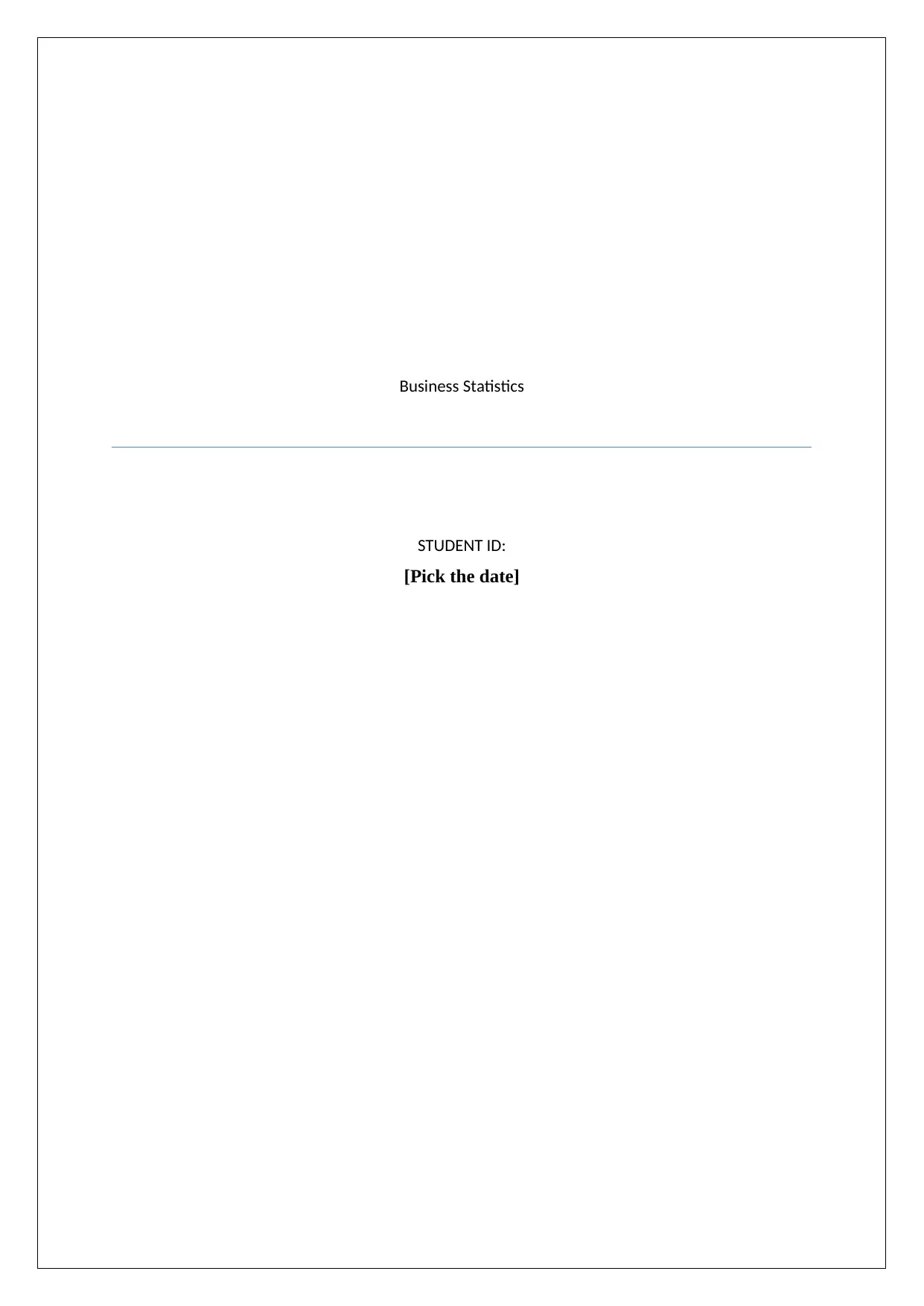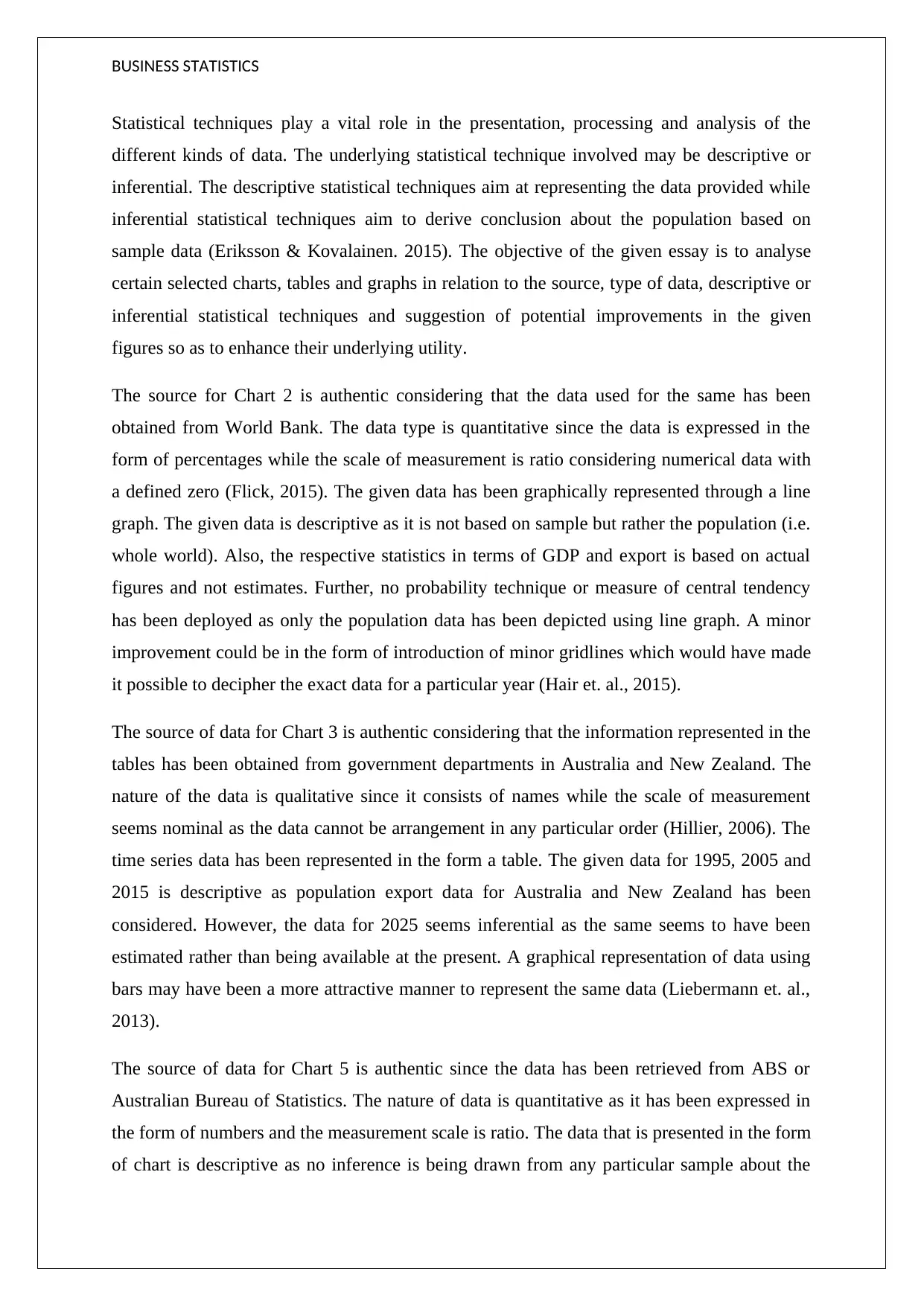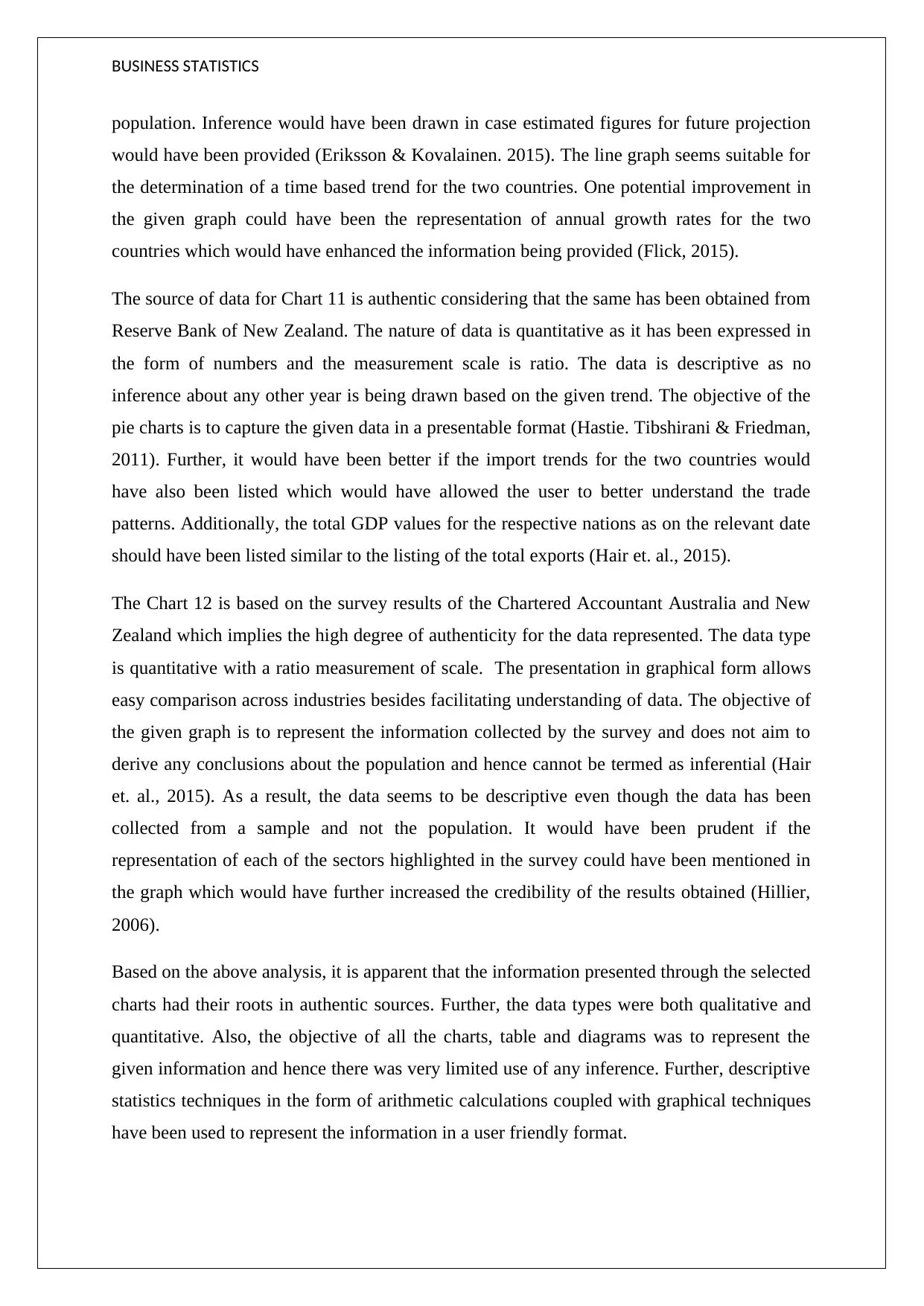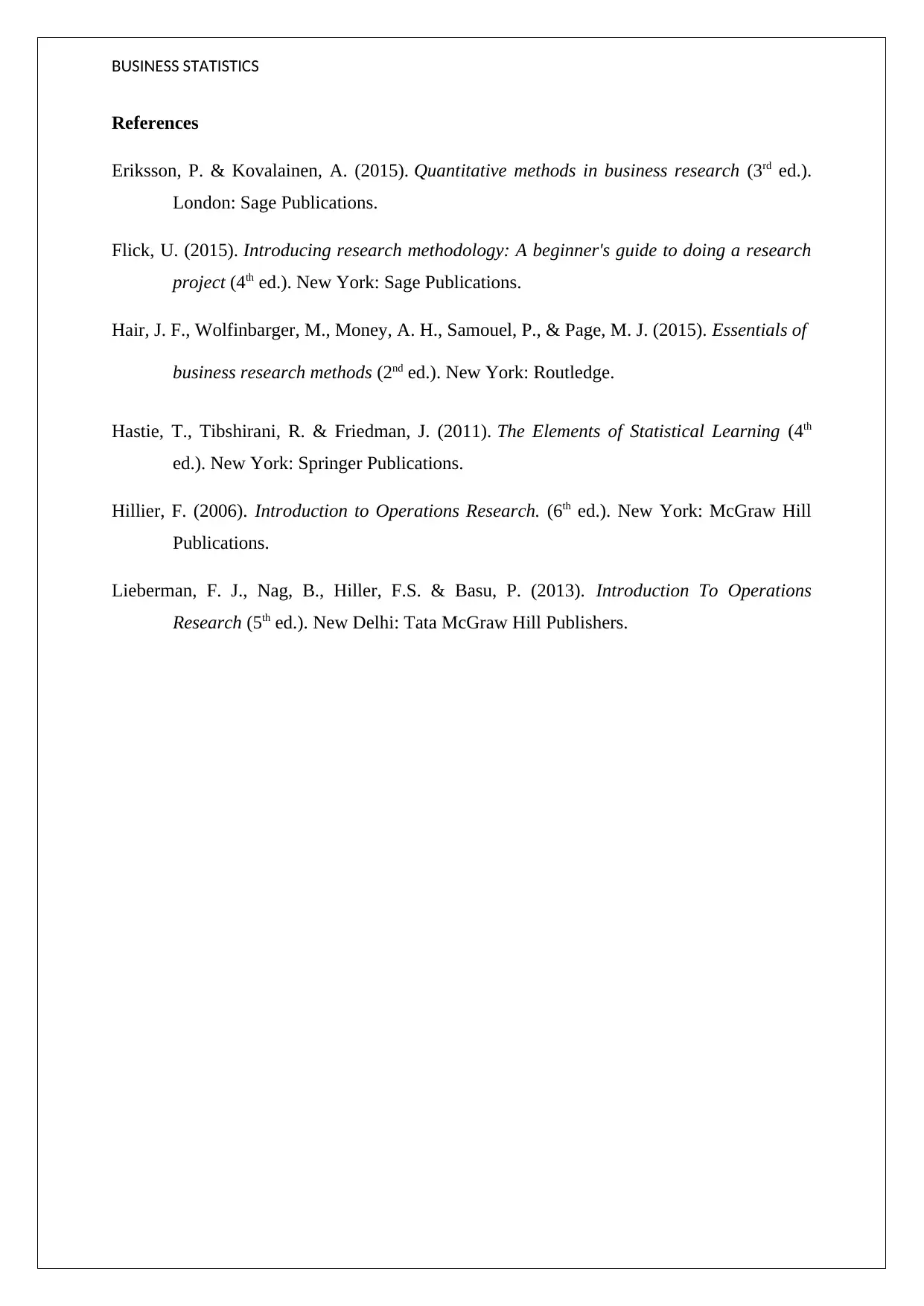Business Statistics Report: Data Analysis and Chart Evaluation
VerifiedAdded on 2020/02/24
|4
|1216
|425
Report
AI Summary
This report provides an analysis of several business statistics charts, tables, and graphs. It examines the source of the data, data types (quantitative and qualitative), and the statistical techniques employed (descriptive and inferential). The report assesses the authenticity of data sources such as the World Bank, government departments, and statistical bureaus. The report also evaluates the suitability of different graphical representations, including line graphs, tables, and pie charts, offering suggestions for potential improvements to enhance the clarity and utility of the presented information. The analysis covers various aspects of the data, including GDP, exports, and survey results, highlighting the descriptive nature of the statistics and the limited use of inferential techniques. The report concludes by emphasizing the use of descriptive statistical techniques and graphical representations to present information in a user-friendly format.

Business Statistics
STUDENT ID:
[Pick the date]
STUDENT ID:
[Pick the date]
Paraphrase This Document
Need a fresh take? Get an instant paraphrase of this document with our AI Paraphraser

BUSINESS STATISTICS
Statistical techniques play a vital role in the presentation, processing and analysis of the
different kinds of data. The underlying statistical technique involved may be descriptive or
inferential. The descriptive statistical techniques aim at representing the data provided while
inferential statistical techniques aim to derive conclusion about the population based on
sample data (Eriksson & Kovalainen. 2015). The objective of the given essay is to analyse
certain selected charts, tables and graphs in relation to the source, type of data, descriptive or
inferential statistical techniques and suggestion of potential improvements in the given
figures so as to enhance their underlying utility.
The source for Chart 2 is authentic considering that the data used for the same has been
obtained from World Bank. The data type is quantitative since the data is expressed in the
form of percentages while the scale of measurement is ratio considering numerical data with
a defined zero (Flick, 2015). The given data has been graphically represented through a line
graph. The given data is descriptive as it is not based on sample but rather the population (i.e.
whole world). Also, the respective statistics in terms of GDP and export is based on actual
figures and not estimates. Further, no probability technique or measure of central tendency
has been deployed as only the population data has been depicted using line graph. A minor
improvement could be in the form of introduction of minor gridlines which would have made
it possible to decipher the exact data for a particular year (Hair et. al., 2015).
The source of data for Chart 3 is authentic considering that the information represented in the
tables has been obtained from government departments in Australia and New Zealand. The
nature of the data is qualitative since it consists of names while the scale of measurement
seems nominal as the data cannot be arrangement in any particular order (Hillier, 2006). The
time series data has been represented in the form a table. The given data for 1995, 2005 and
2015 is descriptive as population export data for Australia and New Zealand has been
considered. However, the data for 2025 seems inferential as the same seems to have been
estimated rather than being available at the present. A graphical representation of data using
bars may have been a more attractive manner to represent the same data (Liebermann et. al.,
2013).
The source of data for Chart 5 is authentic since the data has been retrieved from ABS or
Australian Bureau of Statistics. The nature of data is quantitative as it has been expressed in
the form of numbers and the measurement scale is ratio. The data that is presented in the form
of chart is descriptive as no inference is being drawn from any particular sample about the
Statistical techniques play a vital role in the presentation, processing and analysis of the
different kinds of data. The underlying statistical technique involved may be descriptive or
inferential. The descriptive statistical techniques aim at representing the data provided while
inferential statistical techniques aim to derive conclusion about the population based on
sample data (Eriksson & Kovalainen. 2015). The objective of the given essay is to analyse
certain selected charts, tables and graphs in relation to the source, type of data, descriptive or
inferential statistical techniques and suggestion of potential improvements in the given
figures so as to enhance their underlying utility.
The source for Chart 2 is authentic considering that the data used for the same has been
obtained from World Bank. The data type is quantitative since the data is expressed in the
form of percentages while the scale of measurement is ratio considering numerical data with
a defined zero (Flick, 2015). The given data has been graphically represented through a line
graph. The given data is descriptive as it is not based on sample but rather the population (i.e.
whole world). Also, the respective statistics in terms of GDP and export is based on actual
figures and not estimates. Further, no probability technique or measure of central tendency
has been deployed as only the population data has been depicted using line graph. A minor
improvement could be in the form of introduction of minor gridlines which would have made
it possible to decipher the exact data for a particular year (Hair et. al., 2015).
The source of data for Chart 3 is authentic considering that the information represented in the
tables has been obtained from government departments in Australia and New Zealand. The
nature of the data is qualitative since it consists of names while the scale of measurement
seems nominal as the data cannot be arrangement in any particular order (Hillier, 2006). The
time series data has been represented in the form a table. The given data for 1995, 2005 and
2015 is descriptive as population export data for Australia and New Zealand has been
considered. However, the data for 2025 seems inferential as the same seems to have been
estimated rather than being available at the present. A graphical representation of data using
bars may have been a more attractive manner to represent the same data (Liebermann et. al.,
2013).
The source of data for Chart 5 is authentic since the data has been retrieved from ABS or
Australian Bureau of Statistics. The nature of data is quantitative as it has been expressed in
the form of numbers and the measurement scale is ratio. The data that is presented in the form
of chart is descriptive as no inference is being drawn from any particular sample about the

BUSINESS STATISTICS
population. Inference would have been drawn in case estimated figures for future projection
would have been provided (Eriksson & Kovalainen. 2015). The line graph seems suitable for
the determination of a time based trend for the two countries. One potential improvement in
the given graph could have been the representation of annual growth rates for the two
countries which would have enhanced the information being provided (Flick, 2015).
The source of data for Chart 11 is authentic considering that the same has been obtained from
Reserve Bank of New Zealand. The nature of data is quantitative as it has been expressed in
the form of numbers and the measurement scale is ratio. The data is descriptive as no
inference about any other year is being drawn based on the given trend. The objective of the
pie charts is to capture the given data in a presentable format (Hastie. Tibshirani & Friedman,
2011). Further, it would have been better if the import trends for the two countries would
have also been listed which would have allowed the user to better understand the trade
patterns. Additionally, the total GDP values for the respective nations as on the relevant date
should have been listed similar to the listing of the total exports (Hair et. al., 2015).
The Chart 12 is based on the survey results of the Chartered Accountant Australia and New
Zealand which implies the high degree of authenticity for the data represented. The data type
is quantitative with a ratio measurement of scale. The presentation in graphical form allows
easy comparison across industries besides facilitating understanding of data. The objective of
the given graph is to represent the information collected by the survey and does not aim to
derive any conclusions about the population and hence cannot be termed as inferential (Hair
et. al., 2015). As a result, the data seems to be descriptive even though the data has been
collected from a sample and not the population. It would have been prudent if the
representation of each of the sectors highlighted in the survey could have been mentioned in
the graph which would have further increased the credibility of the results obtained (Hillier,
2006).
Based on the above analysis, it is apparent that the information presented through the selected
charts had their roots in authentic sources. Further, the data types were both qualitative and
quantitative. Also, the objective of all the charts, table and diagrams was to represent the
given information and hence there was very limited use of any inference. Further, descriptive
statistics techniques in the form of arithmetic calculations coupled with graphical techniques
have been used to represent the information in a user friendly format.
population. Inference would have been drawn in case estimated figures for future projection
would have been provided (Eriksson & Kovalainen. 2015). The line graph seems suitable for
the determination of a time based trend for the two countries. One potential improvement in
the given graph could have been the representation of annual growth rates for the two
countries which would have enhanced the information being provided (Flick, 2015).
The source of data for Chart 11 is authentic considering that the same has been obtained from
Reserve Bank of New Zealand. The nature of data is quantitative as it has been expressed in
the form of numbers and the measurement scale is ratio. The data is descriptive as no
inference about any other year is being drawn based on the given trend. The objective of the
pie charts is to capture the given data in a presentable format (Hastie. Tibshirani & Friedman,
2011). Further, it would have been better if the import trends for the two countries would
have also been listed which would have allowed the user to better understand the trade
patterns. Additionally, the total GDP values for the respective nations as on the relevant date
should have been listed similar to the listing of the total exports (Hair et. al., 2015).
The Chart 12 is based on the survey results of the Chartered Accountant Australia and New
Zealand which implies the high degree of authenticity for the data represented. The data type
is quantitative with a ratio measurement of scale. The presentation in graphical form allows
easy comparison across industries besides facilitating understanding of data. The objective of
the given graph is to represent the information collected by the survey and does not aim to
derive any conclusions about the population and hence cannot be termed as inferential (Hair
et. al., 2015). As a result, the data seems to be descriptive even though the data has been
collected from a sample and not the population. It would have been prudent if the
representation of each of the sectors highlighted in the survey could have been mentioned in
the graph which would have further increased the credibility of the results obtained (Hillier,
2006).
Based on the above analysis, it is apparent that the information presented through the selected
charts had their roots in authentic sources. Further, the data types were both qualitative and
quantitative. Also, the objective of all the charts, table and diagrams was to represent the
given information and hence there was very limited use of any inference. Further, descriptive
statistics techniques in the form of arithmetic calculations coupled with graphical techniques
have been used to represent the information in a user friendly format.
⊘ This is a preview!⊘
Do you want full access?
Subscribe today to unlock all pages.

Trusted by 1+ million students worldwide

BUSINESS STATISTICS
References
Eriksson, P. & Kovalainen, A. (2015). Quantitative methods in business research (3rd ed.).
London: Sage Publications.
Flick, U. (2015). Introducing research methodology: A beginner's guide to doing a research
project (4th ed.). New York: Sage Publications.
Hair, J. F., Wolfinbarger, M., Money, A. H., Samouel, P., & Page, M. J. (2015). Essentials of
business research methods (2nd ed.). New York: Routledge.
Hastie, T., Tibshirani, R. & Friedman, J. (2011). The Elements of Statistical Learning (4th
ed.). New York: Springer Publications.
Hillier, F. (2006). Introduction to Operations Research. (6th ed.). New York: McGraw Hill
Publications.
Lieberman, F. J., Nag, B., Hiller, F.S. & Basu, P. (2013). Introduction To Operations
Research (5th ed.). New Delhi: Tata McGraw Hill Publishers.
References
Eriksson, P. & Kovalainen, A. (2015). Quantitative methods in business research (3rd ed.).
London: Sage Publications.
Flick, U. (2015). Introducing research methodology: A beginner's guide to doing a research
project (4th ed.). New York: Sage Publications.
Hair, J. F., Wolfinbarger, M., Money, A. H., Samouel, P., & Page, M. J. (2015). Essentials of
business research methods (2nd ed.). New York: Routledge.
Hastie, T., Tibshirani, R. & Friedman, J. (2011). The Elements of Statistical Learning (4th
ed.). New York: Springer Publications.
Hillier, F. (2006). Introduction to Operations Research. (6th ed.). New York: McGraw Hill
Publications.
Lieberman, F. J., Nag, B., Hiller, F.S. & Basu, P. (2013). Introduction To Operations
Research (5th ed.). New Delhi: Tata McGraw Hill Publishers.
1 out of 4
Related Documents
Your All-in-One AI-Powered Toolkit for Academic Success.
+13062052269
info@desklib.com
Available 24*7 on WhatsApp / Email
![[object Object]](/_next/static/media/star-bottom.7253800d.svg)
Unlock your academic potential
Copyright © 2020–2025 A2Z Services. All Rights Reserved. Developed and managed by ZUCOL.





